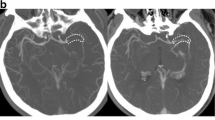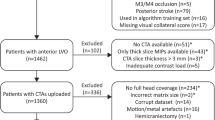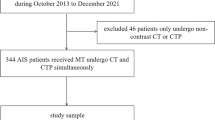Abstract
Objectives
This study compared the diagnostic accuracy of pretreatment circulation collateral scoring (CS) system using digital subtraction angiography (DSA) and computed tomography angiography (CTA) in predicting favorable functional outcome (FFO) after intra-arterial endovascular thrombectomy (IA-EVT). Subgroup analysis characterizing scoring systems within each category was additionally conducted.
Materials and methods
We performed a diagnostic meta-analysis to assess the sensitivity and specificity of each CS system by using DSA and CTA, respectively. The hierarchical summary receiver operating characteristic curve (HSROC) models were used to estimate the diagnostic odds ratio (DOR) and area under the curve (AUC). The Bayes theorem was employed to determine posttest probability (PTP).
Results
In total, 14 and 21 studies were assessed with DSA and CTA, respectively. In DSA, the pooled sensitivity and specificity were 0.72 (95% CI, 0.63–0.79) and 0.61 (0.53–0.68), respectively, and in the HSROC model, the DOR was 3.94 (2.71–5.73), and the AUC was 0.71 (90.67–0.75). CTA revealed a pooled sensitivity and specificity of 0.74 (0.64–0.82) and 0.53 (0.44–0.62), respectively, and in the HSROC model, the DOR was 3.17 (2.34–4.50), and the AUC was 0.67 (0.63–0.71). With a pretest probability of 26.3%, the CS in DSA and CTA exhibited limited increase of PTPs of 39% and 36%, respectively, in detecting the FFO on day 90.
Conclusion
DSA and CTA have comparable accuracy and are limited in predicting the functional outcome. The collateral score systems assessed with DSA and CTA were more suitable for screening than diagnosis for patients before IA-EVT.
Key Points
• Our study revealed the differences of various scoring systems for assessing collateral status.
• DSA and CTA have comparable accuracy, but both imaging modalities played relatively limited roles in predicting functional outcome on day 90.
• The collateral score systems assessed with DSA and CTA were more suitable for screening than diagnosis for patients before IA-EVT.




Similar content being viewed by others
Abbreviations
- ASITN/SIR:
-
American Society of Intervention and Therapeutic Neuroradiology/Society of Interventional Radiology
- AUC:
-
Area under the curve
- CS:
-
Collateral scoring
- CTA:
-
Computed tomography angiography
- DOR:
-
Diagnostic odds ratio
- DSA:
-
Digital subtraction angiography
- FFO:
-
Favorable functional outcome
- HSROC:
-
Hierarchical summary receiver operating characteristic curve
- IA-EVT:
-
Intra-arterial endovascular thrombectomy
- mRS:
-
Modified Rankin Scale
- PTP:
-
Posttest probability
- rLMC:
-
Regional leptomeningeal collateral
References
Berkhemer OA, Fransen PS, Beumer D et al (2015) A randomized trial of intraarterial treatment for acute ischemic stroke. N Engl J Med 372:11–20
Goyal M, Demchuk AM, Menon BK et al (2015) Randomized assessment of rapid endovascular treatment of ischemic stroke. N Engl J Med 372:1019–1030
Saver JL, Goyal M, Bonafe A et al (2015) Stent-retriever thrombectomy after intravenous t-PA vs. t-PA alone in stroke. N Engl J Med 372:2285–2295
Campbell BC, Mitchell PJ, Kleinig TJ et al (2015) Endovascular therapy for ischemic stroke with perfusion-imaging selection. N Engl J Med 372:1009–1018
Jovin TG, Chamorro A, Cobo E et al (2015) Thrombectomy within 8 hours after symptom onset in ischemic stroke. N Engl J Med 372:2296–2306
Albers GW, Marks MP, Kemp S et al (2018) Thrombectomy for Stroke at 6 to 16 hours with selection by perfusion imaging. N Engl J Med 378:708–718
Nogueira RG, Jadhav AP, Haussen DC et al (2018) Thrombectomy 6 to 24 hours after stroke with a mismatch between deficit and infarct. N Engl J Med 378:11–21
Vagal A, Aviv R, Sucharew H et al (2018) Collateral clock is more important than time clock for tissue fate. Stroke 49:2102–2107
Rusanen H, Saarinen JT, Sillanpaa N (2015) Collateral Circulation predicts the size of the infarct core and the proportion of salvageable penumbra in hyperacute ischemic stroke patients treated with intravenous thrombolysis. Cerebrovasc Dis 40:182–190
Qian J, Fan L, Zhang W, Wang J, Qiu J, Wang Y (2020) A meta-analysis of collateral status and outcomes of mechanical thrombectomy. Acta Neurol Scand 142:191–199
Yeo LL, Paliwal P, Teoh HL et al (2015) Assessment of intracranial collaterals on CT angiography in anterior circulation acute ischemic stroke. AJNR Am J Neuroradiol 36:289–294
Sung SM, Lee TH, Cho HJ et al (2015) Functional outcome after recanalization for acute pure M1 occlusion of the middle cerebral artery as assessed by collateral CTA flow. Clin Neurol Neurosurg 131:72–76
Liu L, Ding J, Leng X et al (2018) Guidelines for evaluation and management of cerebral collateral circulation in ischaemic stroke 2017. Stroke Vasc Neurol 3:117–130
Liberati A, Altman DG, Tetzlaff J et al (2009) The PRISMA statement for reporting systematic reviews and meta-analyses of studies that evaluate healthcare interventions: explanation and elaboration. BMJ 339:b2700
Whiting PF, Rutjes AW, Westwood ME et al (2011) QUADAS-2: a revised tool for the quality assessment of diagnostic accuracy studies. Ann Intern Med 155:529–536
Higgins JP, Thompson SG, Deeks JJ, Altman DG (2003) Measuring inconsistency in meta-analyses. BMJ 327:557–560
Hartzes AM, Morgan CJ (2019) Meta-analysis for diagnostic tests. J Nucl Cardiol 26:68–71
Leeflang MM (2014) Systematic reviews and meta-analyses of diagnostic test accuracy. Clin Microbiol Infect 20:105–113
Deeks JJ, Macaskill P, Irwig L (2005) The performance of tests of publication bias and other sample size effects in systematic reviews of diagnostic test accuracy was assessed. J Clin Epidemiol 58:882–893
Higashida RT, Furlan AJ, Roberts H et al (2003) Trial design and reporting standards for intra-arterial cerebral thrombolysis for acute ischemic stroke. Stroke 34:e109–e137
Christoforidis GA, Mohammad Y, Kehagias D, Avutu B, Slivka AP (2005) Angiographic assessment of pial collaterals as a prognostic indicator following intra-arterial thrombolysis for acute ischemic stroke. AJNR Am J Neuroradiol 26:1789–1797
Mangiafico S, Consoli A, Renieri L et al (2013) Semi-quantitative and qualitative evaluation of pial leptomeningeal collateral circulation in acute ischemic stroke of the anterior circulation: the Careggi Collateral Score. Ital J Anat Embryol 118:277–287
Al-Ali F, Jefferson A, Barrow T et al (2013) The capillary index score: rethinking the acute ischemic stroke treatment algorithm. Results from the Borgess Medical Center Acute Ischemic Stroke Registry. J Neurointerv Surg 5:139–143
Tan IY, Demchuk AM, Hopyan J et al (2009) CT angiography clot burden score and collateral score: correlation with clinical and radiologic outcomes in acute middle cerebral artery infarct. AJNR Am J Neuroradiol 30:525–531
Souza LC, Yoo AJ, Chaudhry ZA et al (2012) Malignant CTA collateral profile is highly specific for large admission DWI infarct core and poor outcome in acute stroke. AJNR Am J Neuroradiol 33:1331–1336
Menon BK, Smith EE, Modi J et al (2011) Regional leptomeningeal score on CT angiography predicts clinical and imaging outcomes in patients with acute anterior circulation occlusions. AJNR Am J Neuroradiol 32:1640–1645
Miteff F, Levi CR, Bateman GA, Spratt N, McElduff P, Parsons MW (2009) The independent predictive utility of computed tomography angiographic collateral status in acute ischaemic stroke. Brain 132:2231–2238
Maas MB, Lev MH, Ay H et al (2009) Collateral vessels on CT angiography predict outcome in acute ischemic stroke. Stroke 40:3001–3005
Kim JT, Liebeskind DS, Jahan R et al (2018) Impact of hyperglycemia according to the collateral status on outcomes in mechanical thrombectomy. Stroke 49:2706–2714
Singer OC, Berkefeld J, Nolte CH et al (2015) Collateral vessels in proximal middle cerebral artery occlusion: the ENDOSTROKE study. Radiology 274:851–858
Hwang YH, Kang DH, Kim YW, Kim YS, Park SP, Liebeskind DS (2015) Impact of time-to-reperfusion on outcome in patients with poor collaterals. AJNR Am J Neuroradiol 36:495–500
Sheth SA, Sanossian N, Hao Q et al (2016) Collateral flow as causative of good outcomes in endovascular stroke therapy. J Neurointerv Surg 8:2–7
Liebeskind DS, Tomsick TA, Foster LD et al (2014) Collaterals at angiography and outcomes in the Interventional Management of Stroke (IMS) III trial. Stroke 45:759–764
Liebeskind DS, Jahan R, Nogueira RG, Zaidat OO, Saver JL, Investigators S (2014) Impact of collaterals on successful revascularization in Solitaire FR with the intention for thrombectomy. Stroke 45:2036–2040
Marks MP, Lansberg MG, Mlynash M et al (2014) Effect of collateral blood flow on patients undergoing endovascular therapy for acute ischemic stroke. Stroke 45:1035–1039
Sallustio F, Motta C, Pizzuto S et al (2017) CT angiography-based collateral flow and time to reperfusion are strong predictors of outcome in endovascular treatment of patients with stroke. J Neurointerv Surg 9:940–943
Ribo M, Flores A, Rubiera M et al (2011) Extending the time window for endovascular procedures according to collateral pial circulation. Stroke 42:3465–3469
Mangiafico S, Saia V, Nencini P et al (2014) Effect of the interaction between recanalization and collateral circulation on functional outcome in acute ischaemic stroke. Interv Neuroradiol 20:704–714
Duan Z, Huang X, Gao J et al (2020) Application of capillary index score in predicting three-month functional outcome after endovascular treatment for acute ischemic stroke in China. Interv Neuroradiol 26:309–315
Al-Ali F, Berkhemer OA, Yousman WP et al (2016) The capillary index score as a marker of viable cerebral tissue: proof of concept-the capillary index score in the MR CLEAN (Multicenter Randomized Clinical Trial of Endovascular Treatment for Acute Ischemic Stroke in the Netherlands) trial. Stroke 47:2286–2291
Labeyrie PE, Redjem H, Blanc R et al (2016) The Capillary Index Score before thrombectomy: an angiographic correlate of favorable outcome. J Neurointerv Surg 8:1119–1122
Rai AT, Jhadhav Y, Domico J, Hobbs GR (2012) Procedural predictors of outcome in patients undergoing endovascular therapy for acute ischemic stroke. Cardiovasc Intervent Radiol 35:1332–1339
Hassler E, Kneihsl M, Deutschmann H et al (2020) Relationship between stroke etiology and collateral status in anterior circulation large vessel occlusion. J Neurol 267:3362–3370
Jansen IG, Mulder MJ, Goldhoorn RB et al (2019) Impact of single phase CT angiography collateral status on functional outcome over time: results from the MR CLEAN Registry. J Neurointerv Surg 11:866–873
Cao R, Qi P, Liu Y, Ma X, Shen Z, Chen J (2019) Improving prognostic evaluation by 4D CTA for Endovascular treatment in acute ischemic stroke patients: a preliminary study. J Stroke Cerebrovasc Dis 28:1971–1978
Yeo LL, Andersson T, Holmberg A et al (2019) Posterior communicating and anterior communicating arteries on pre-thrombectomy computed tomography scans are associated with good outcomes irrespective of leptomeningeal collateral status. Interv Neuroradiol 25:364–370
de Havenon A, Mlynash M, Kim-Tenser MA et al (2019) Results From DEFUSE 3: good collaterals are associated with reduced ischemic core growth but not neurologic outcome. Stroke 50:632–638
Nordmeyer H, Webering N, Chapot R et al (2017) The association between collateral status, recanalization and long term outcome in stroke patients treated with stent retrievers - are there indications not to perform thrombectomy based on CT angiography? J Neuroradiol 44:217–222
Schonenberger S, Pfaff J, Uhlmann L et al (2017) The impact of conscious sedation versus general anesthesia for stroke thrombectomy on the predictive value of collateral status: a post hoc analysis of the SIESTA trial. AJNR Am J Neuroradiol 38:1580–1585
Berkhemer OA, Jansen IG, Beumer D et al (2016) Collateral Status on baseline computed tomographic angiography and intra-arterial treatment effect in patients with proximal anterior circulation stroke. Stroke 47:768–776
Gerber JC, Petrova M, Krukowski P et al (2016) Collateral state and the effect of endovascular reperfusion therapy on clinical outcome in ischemic stroke patients. Brain Behav 6:e00513
Garcia-Tornel A, Carvalho V, Boned S et al (2016) Improving the evaluation of collateral circulation by multiphase computed tomography angiography in acute stroke patients treated with endovascular reperfusion therapies. Interv Neurol 5:209–217
Ko CC, Liu HM, Chen TY et al (2020) Prediction of mTICI 3 recanalization and clinical outcomes in endovascular thrombectomy for acute ischemic stroke: a retrospective study in the Taiwan registry. Neurol Sci. https://doi.org/10.1007/s10072-020-04800-z
Broocks G, Kemmling A, Meyer L et al (2019) Computed tomography angiography collateral profile is directly linked to early edema progression rate in acute ischemic stroke. Stroke 50:3424–3430
Park JS, Kwak HS, Chung GH, Hwang S (2018) The prognostic value of CT-angiographic parameters after reperfusion therapy in acute ischemic stroke patients with internal carotid artery terminus occlusion: leptomeningeal collateral status and clot burden score. J Stroke Cerebrovasc Dis 27:2797–2803
Gersing AS, Schwaiger BJ, Kleine JF et al (2017) Clinical outcome predicted by collaterals depends on technical success of mechanical thrombectomy in middle cerebral artery occlusion. J Stroke Cerebrovasc Dis 26:801–808
Nambiar V, Sohn SI, Almekhlafi MA et al (2014) CTA collateral status and response to recanalization in patients with acute ischemic stroke. AJNR Am J Neuroradiol 35:884–890
van Horn N, Kniep H, Leischner H et al (2021) Predictors of poor clinical outcome despite complete reperfusion in acute ischemic stroke patients. J Neurointerv Surg 13:14–18
Kim BJ, Chung JW, Park HK et al (2017) CT angiography of collateral vessels and outcomes in endovascular-treated acute ischemic stroke patients. J Clin Neurol 13:121–128
Chang JY, Jeon SB, Jung C, Gwak DS, Han MK (2019) Postreperfusion blood pressure variability after endovascular thrombectomy affects outcomes in acute ischemic stroke patients with poor collateral circulation. Front Neurol 10:346
Gavriliuc P, Kharouba R, Cohen JE, Gomori JM, Yaghmour N, Leker RR (2018) Clot length does not impact outcome following thrombectomy. J Neurol Sci 395:91–94
Seeta Ramaiah S, Churilov L, Mitchell P, Dowling R, Yan B (2014) The impact of arterial collateralization on outcome after intra-arterial therapy for acute ischemic stroke. AJNR Am J Neuroradiol 35:667–672
Kim BM, Baek JH, Heo JH et al (2018) Collateral status affects the onset-to-reperfusion time window for good outcome. J Neurol Neurosurg Psychiatry 89:903–909
van den Wijngaard IR, Holswilder G, Wermer MJ et al (2016) Assessment of collateral status by dynamic CT angiography in acute MCA stroke: timing of acquisition and relationship with final infarct volume. AJNR Am J Neuroradiol 37:1231–1236
Kaschka IN, Kloska SP, Struffert T et al (2016) Clot burden and collaterals in anterior circulation stroke: differences between single-phase CTA and multi-phase 4D-CTA. Clin Neuroradiol 26:309–315
Beyer SE, Thierfelder KM, von Baumgarten L et al (2015) Strategies of collateral blood flow assessment in ischemic stroke: prediction of the follow-up infarct volume in conventional and dynamic CTA. AJNR Am J Neuroradiol 36:488–494
Menon BK, d'Esterre CD, Qazi EM et al (2015) Multiphase CT angiography: a new tool for the imaging triage of patients with acute ischemic stroke. Radiology 275:510–520
Smit EJ, Vonken EJ, van Seeters T et al (2013) Timing-invariant imaging of collateral vessels in acute ischemic stroke. Stroke 44:2194–2199
Smit EJ, Vonken EJ, van der Schaaf IC et al (2012) Timing-invariant reconstruction for deriving high-quality CT angiographic data from cerebral CT perfusion data. Radiology 263:216–225
Ben Hassen W, Malley C, Boulouis G et al (2019) Inter- and intraobserver reliability for angiographic leptomeningeal collateral flow assessment by the American Society of Interventional and Therapeutic Neuroradiology/Society of Interventional Radiology (ASITN/SIR) scale. J Neurointerv Surg 11:338–341
Kamalian S, Kemmling A, Borgie RC et al (2013) Admission insular infarction >25% is the strongest predictor of large mismatch loss in proximal middle cerebral artery stroke. Stroke 44:3084–3089
Kaesmacher J, Chaloulos-Iakovidis P, Panos L et al (2019) Mechanical thrombectomy in ischemic stroke patients with Alberta Stroke Program early computed tomography score 0-5. Stroke 50:880–888
Cagnazzo F, Derraz I, Dargazanli C et al (2020) Mechanical thrombectomy in patients with acute ischemic stroke and ASPECTS </=6: a meta-analysis. J Neurointerv Surg 12:350–355
Diestro JDB, Dmytriw AA, Broocks G et al (2020) Endovascular thrombectomy for low ASPECTS large vessel occlusion ischemic stroke: a systematic review and meta-analysis. Can J Neurol Sci 47:612–619
Broocks G (December 1, 2021-) Improving low Alberta Stroke Program early ct score stroke thrombectomy. Available via https://clinicaltrials.gov/ct2/show/record/NCT04862507
Acknowledgements
Data curation and investigation were performed by Wei-Zhen Lu, Hui-An Lin, Chyi-Huey Bai, Sen-Kuang Hou, and Sheng-Feng Lin. Wei-Zhen Lu (first author) and Hui-An Lin (co-first author) contributed equally. Formal analysis and software were conducted by Sheng-Feng Lin. Original draft was wrote by Wei-Zhen Lu, Hui-An Lin, and Sheng-Feng Lin. Final review and editing of the draft were performed by Wei-Zhen Lu and Sheng-Feng Lin.
Funding
The authors state that this work has not received any funding.
Author information
Authors and Affiliations
Corresponding author
Ethics declarations
Guarantor
The scientific guarantor of this publication is Sheng-Feng Lin.
Conflict of interest
The authors of this manuscript declare no relationships with any companies whose products or services may be related to the subject matter of the article.
Statistics and biometry
One of the authors, Sheng-Feng Lin, has significant statistical expertise.
Informed consent
This study was a systemic review and meta-analysis. No informed consent and ethical committee review were required. This study was registered on PROSPERO (reference number: CRD42021237879).
Ethical approval
This study was registered on PROSPERO (reference number: CRD42021237879). This study was a systemic review and meta-analysis. No informed consent and ethical committee review were required.
Methodology
-
Retrospective
-
Diagnostic or prognostic study
-
Multicentre study
Additional information
Publisher’s note
Springer Nature remains neutral with regard to jurisdictional claims in published maps and institutional affiliations.
Wei-Zhen Lu is the first author, and Hui-An Lin is the co-first author.
Supplementary Information
ESM 1
(DOCX 11730 kb)
Rights and permissions
About this article
Cite this article
Lu, WZ., Lin, HA., Hou, SK. et al. Diagnostic test accuracy of pretreatment collateral score in predicting stroke outcomes after intra-arterial endovascular thrombectomy: a meta-analysis in DSA and CTA . Eur Radiol 32, 6097–6107 (2022). https://doi.org/10.1007/s00330-022-08706-6
Received:
Revised:
Accepted:
Published:
Issue Date:
DOI: https://doi.org/10.1007/s00330-022-08706-6




